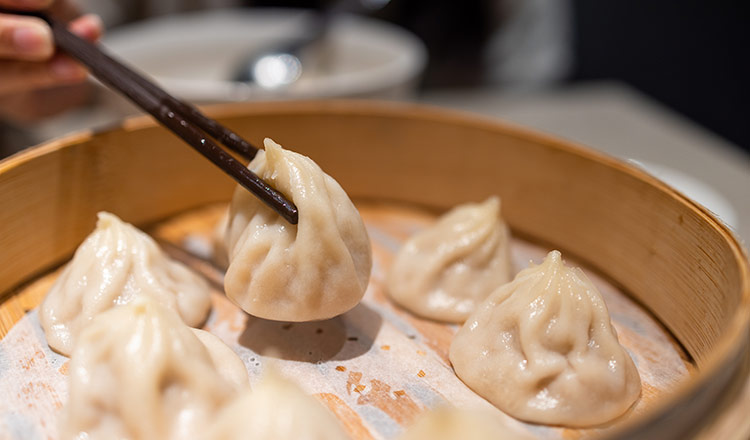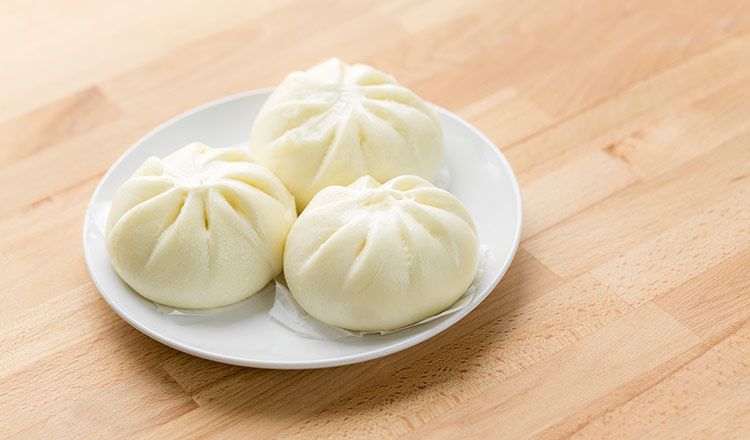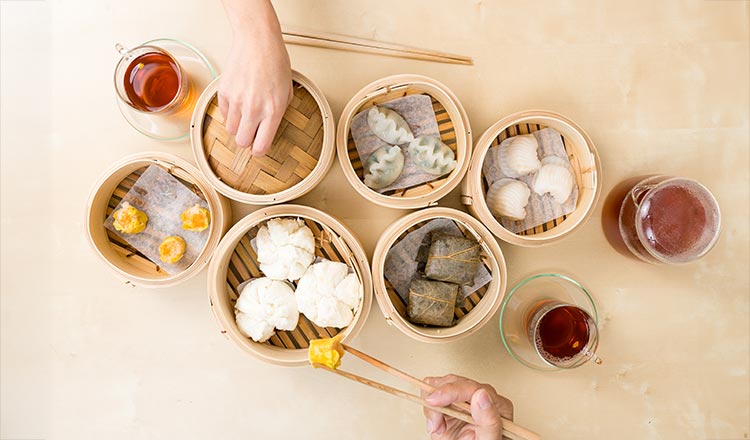Many people think dim sum is Guangdong (Cantonese) food because most Guangdong restaurants in the United States serve dim sum at brunch. However, dim sum is the Cantonese pronunciation for the mandarin term “dian-xin (pronunciation is shing)” meaning light refreshments or pastries. In China, there are “hot food chefs” and “dian xin chefs”, just like pastry chefs in a western kitchen. Both type of chefs lead very different culinary careers.
Dim sum is part of the Chinese local cuisine. Each region in China has its own unique dim sum. For instant, har gao is a typical Guangdong (Cantonese) dim sum dish. It can be found in Sichuan or Beijing restaurants, but everyone seems to know that it is not local Dim sum. Instead, it is a Guangdong flavor because it is the only dumpling in China that has a wrapper made from pure starches. Most of the time the ingredient used is wheat starch or also, tapioca starch or corn starch. The wrapper will turn to translucent after being steamed.
A “chive box pie” represents northern or Beijing style dim sum while “ye-er-ba”, a steamed rice dumpling with meat or sweet stuffing wrapped with bamboo leaves or bok choy, is a popular Sichuan dim sum. Almost everyone in China knows “shuijianbao”, a Shanghai local dim sum of water pan-fried dumplings.
The definition of dim sum refers mainly to a pastry type dish, although it can also extend in meaning to snacks or appetizers. It is called “Xiaochi” (pronunciation: Shiaochi), which is directly translated to “light or small food.” It includes dim sum and other snacks. This is why one could find steamed pork ribs with black bean sauce, chicken feet, beef trips with five spice sauce, dan dan noodles, and spicy bean jelly noodle in a dim sum house or on a restaurant’s dim sum menu.
China is a vast country with a rich culinary culture. There are countless dim sum and Xiaochi in each region. For example, according to the book of Sichuan dim sum (Chinese dim sum –Sichuan Region), there are more than five hundred types of local dim sum. Dim sum not only is served in a teahouse or dim sum house as breakfast and brunch, but also may be served to a banquet as a break between two dishes. This is done in many restaurants to clean the palate between courses.
The cooking methods used to make dim sum are varied, such as deep-fry, steam, pan-fry, boil, and bake. Ingredients use to make dim sum vary even more. Usually there are three kinds: wheat products such as wheat flour and wheat starch; rice products like rice flour, difference rice; and grains or beans. In northern China, most dim sum is made of wheat flour, such as chive box pie, scallion pancake, and pot stickers. Yet in southern China, more rice products are used in making dim sum, for example sweet rice dumplings, steamed rice dumpling with green leaves, fen chang (a fresh rice wrapper roll) and pearl ball (the name is for a white shiny steamed glutinous rice coated meat ball).
dim sum can be differentiated one from another by the stuffing use. They can be salty, savory or sweet. For example, a steamed bun, the outside dough is usually made of wheat flour, yeast, and water. However, the stuffing could be ground pork, chicken, beef, seafood, or vegetables for salty savory flavor profile. However, the stuffing could be sweet red bean paste, sweet lotus seed paste, sweet taro root paste, or nuts and sweet dates served as dessert.
 The dough used for most dim sum are three types, one is cold water dough which used to make a wrapper of boiling jiaozi (pot stickers), wonton, shaomai, and noodles. The texture of this kind of wrapper is hard, strong, al dente; another is boiling water dough which means the flour is halfway cooked so the dough comes out very soft and is easy to make into different shapes. It requires a very short time to cook and usually used to make steamed dumplings, such as har gao (steamed shrimp dumpling), four color dumplings (steamed dumpling with vegetables and eggs on top), and fen gao (steamed pork dumpling). The third type of dough is half boiling water dough and half cold water dough mixture. Obviously, it combined the texture of other two types of dough so it is not as hard as cold water dough nor as soft as boiling water dough. This kind of dough is most commonly used in northern of China. It is typically used for Scallion Pancake, Chinese chive box pie or anything used for pan frying.
The dough used for most dim sum are three types, one is cold water dough which used to make a wrapper of boiling jiaozi (pot stickers), wonton, shaomai, and noodles. The texture of this kind of wrapper is hard, strong, al dente; another is boiling water dough which means the flour is halfway cooked so the dough comes out very soft and is easy to make into different shapes. It requires a very short time to cook and usually used to make steamed dumplings, such as har gao (steamed shrimp dumpling), four color dumplings (steamed dumpling with vegetables and eggs on top), and fen gao (steamed pork dumpling). The third type of dough is half boiling water dough and half cold water dough mixture. Obviously, it combined the texture of other two types of dough so it is not as hard as cold water dough nor as soft as boiling water dough. This kind of dough is most commonly used in northern of China. It is typically used for Scallion Pancake, Chinese chive box pie or anything used for pan frying.
To become a dim sum chef, it takes years of practice and training. It is very much like a Japanese sushi chef or a western pastry chef. They require great hand skills, artistic eyes, and a creative mind. Making dim sum undoubtedly is not only a skill, but also a fun, a challenge, a exploration, and an enjoyment.


